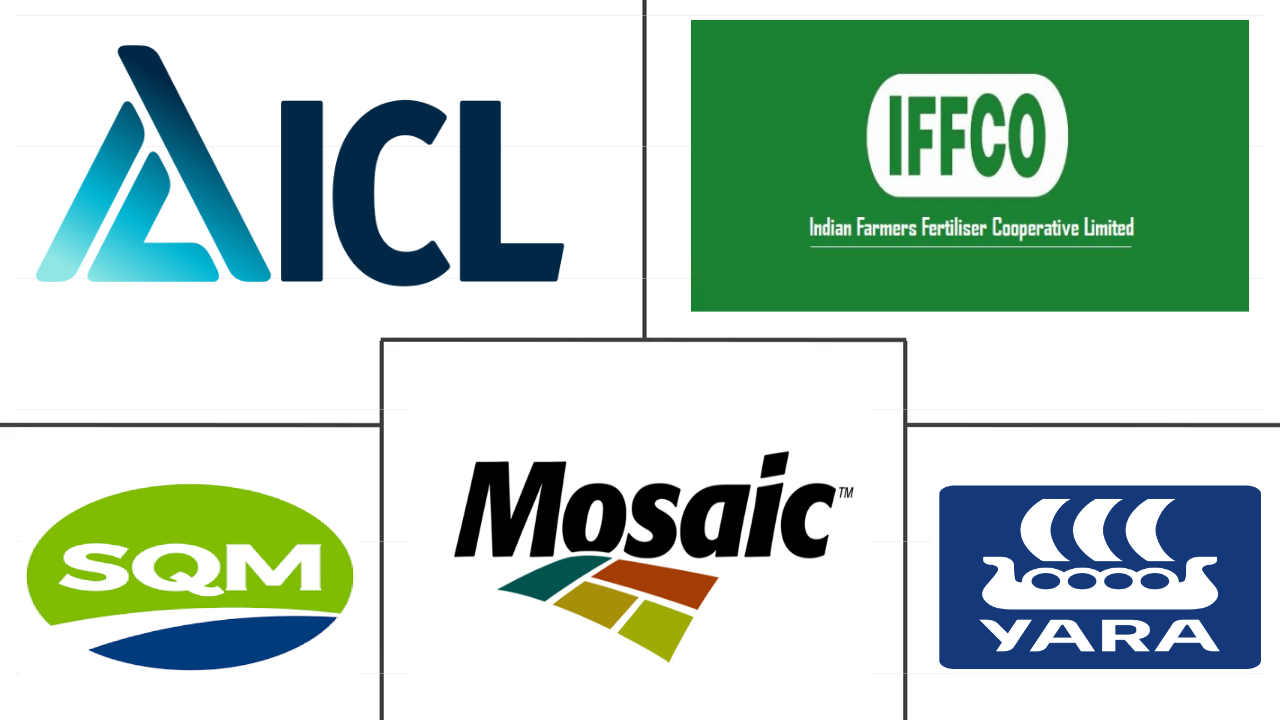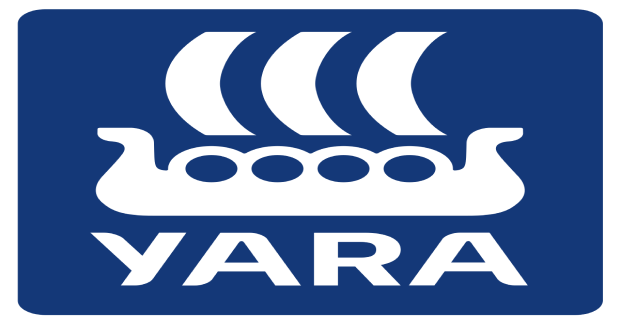Market Size of foliar fertilizer Industry
| Icons | Lable | Value |
|---|---|---|
|
|
Study Period | 2017 - 2030 |
|
|
Market Size (2024) | USD 20.24 Billion |
|
|
Market Size (2030) | USD 28.72 Billion |
|
|
Largest Share by Crop Type | Field Crops |
|
|
CAGR (2024 - 2030) | 6.01 % |
|
|
Largest Share by Region | Asia-Pacific |
|
|
Market Concentration | Medium |
Major Players |
||

|
||
|
*Disclaimer: Major Players sorted in no particular order |
Foliar Fertilizer Market Analysis
The Foliar Fertilizer Market size is estimated at 20.24 billion USD in 2024, and is expected to reach 28.72 billion USD by 2030, growing at a CAGR of 6.01% during the forecast period (2024-2030).
20.24 Billion
Market Size in 2024 (USD)
28.72 Billion
Market Size in 2030 (USD)
6.49 %
CAGR (2017-2023)
6.01 %
CAGR (2024-2030)
Largest segment by Type
40.31 %
value share, Nitrogenous, 2023
Nitrogen is a crucial nutrient for plant growth and enhances yield, foliar nitrogen fertilizers are widely used across the regions to address nitrogen deficiency promptly.
Largest Segment by Crop Type
7.13 %
Projected CAGR, Horticultural Crops, 2024-2030
Farmers are turning to high-quality horticultural crops, and ability of foliar applications of nutrients to quickly address the deficiencies is driving the segment's growth.
Largest segment by Country
32.64 %
value share, China, 2023
With the ability of foliar fertilizer to address nutrient deficiency quickly, and reduce nutrient losses, the demand for foliar fertilizers is growing in China.
Fastest Growing by Country
6.94 %
Projected CAGR, Russia, 2024-2030
Agriculture remains one of the most important sectors in the Russian economy, and the country’s authorities perceive it as one of the potential economic growth drivers.
Leading Market Player
18.87 %
market share, Yara International ASA, 2022

Yara International ASA has a strong presence in major agriculture-producing regions, YaraVita is one of the popular foliar liquid fertilizers brand of the company.
The various benefits associated with a foliar application are driving the adoption of the foliar method
- The field crops segment accounted for 78.3% of the overall foliar fertilizer market value in 2022. More than 85% of the world's agricultural acreage is focused on the cultivation of field crops, which accounts for the huge use of foliar fertilizers by these crops.
- Asia-Pacific and North America together held a market value share of 70.4% in 2022. This was due to the presence of a large field crop cultivation area, which accounted for about 58.0% of the total field crop cultivation area worldwide during the same period. North America accounted for 26.7%, and Asia-Pacific accounted for a share of 41.7% of the usage of foliar fertilizers in field crops in 2022.
- The horticultural crops held a value share of 18.2% of the global foliar fertilizer value and accounted for USD 4.4 billion in 2022. Foliar fertilization allows for precise and targeted nutrient delivery directly to the plant’s leaves. This is particularly beneficial in horticulture, where specific nutrient requirements for different crops and stages of growth need to be met. Furthermore, the foliar application provides a quick response to nutrient deficiencies, ensuring that plants receive essential nutrients when they need them most. Due to these factors, the adoption of foliar fertilizers is growing significantly across the region.
- The demand for foliar fertilizers in the turf and ornament crop segment is projected to register a CAGR of 5.2% in terms of value from 2023 to 2030. This uptick is driven by the increasing demand for ornamentals to enhance aesthetics and quality of life, as well as the need for turf maintenance in public spaces.
The rising prevalence of soil nutrient deficiencies is driving the demand for foliar fertilizers
- Foliar application of fertilizers is a widely adopted practice in global crop production, especially in the cereal and horticulture industries. This method offers a swift response to nutrient deficiencies, ensuring plants receive vital nutrients at critical growth stages.
- In 2022, Asia-Pacific held the largest share in the foliar fertilizer market, reaching a value of USD 11.3 billion, with a consumption volume of 11.9 million metric tons. Field crops accounted for the majority share, capturing 72.4% of the market, valued at USD 8.2 billion.
- Europe, a significant player in the foliar fertilizer market, held a 16.0% market value share in 2022, witnessing a robust growth of 76.9% during the study period. Micronutrient deficiencies, particularly in manganese, zinc, and iron, have been a concern for crop quality and yield in several European regions. Studies indicate that around 60.0% and 28.0% of the region's soil had insufficient iron and zinc levels, respectively, underscoring the market's growth drivers.
- South America contributed 5.8% to the global foliar market. During the study period, the region saw a notable uptick, with the foliar market growing by 62.1% and consumption by volume rising by 27.1%. Projections indicate a 5.9% CAGR for the market value from 2023 to 2030.
- The global demand for foliar fertilizers is set to rise, driven by the adoption of precision farming, protected agriculture, and a heightened need for soil micronutrients to enhance agricultural yields. Foliar fertilization, with its targeted nutrient delivery to leaves, is expected to fuel this demand, leading to a projected 5.9% CAGR from 2023 to 2030.
Foliar Fertilizer Industry Segmentation
Complex, Straight are covered as segments by Type. Field Crops, Horticultural Crops, Turf & Ornamental are covered as segments by Crop Type. Asia-Pacific, Europe, Middle East & Africa, North America, South America are covered as segments by Region.
- The field crops segment accounted for 78.3% of the overall foliar fertilizer market value in 2022. More than 85% of the world's agricultural acreage is focused on the cultivation of field crops, which accounts for the huge use of foliar fertilizers by these crops.
- Asia-Pacific and North America together held a market value share of 70.4% in 2022. This was due to the presence of a large field crop cultivation area, which accounted for about 58.0% of the total field crop cultivation area worldwide during the same period. North America accounted for 26.7%, and Asia-Pacific accounted for a share of 41.7% of the usage of foliar fertilizers in field crops in 2022.
- The horticultural crops held a value share of 18.2% of the global foliar fertilizer value and accounted for USD 4.4 billion in 2022. Foliar fertilization allows for precise and targeted nutrient delivery directly to the plant’s leaves. This is particularly beneficial in horticulture, where specific nutrient requirements for different crops and stages of growth need to be met. Furthermore, the foliar application provides a quick response to nutrient deficiencies, ensuring that plants receive essential nutrients when they need them most. Due to these factors, the adoption of foliar fertilizers is growing significantly across the region.
- The demand for foliar fertilizers in the turf and ornament crop segment is projected to register a CAGR of 5.2% in terms of value from 2023 to 2030. This uptick is driven by the increasing demand for ornamentals to enhance aesthetics and quality of life, as well as the need for turf maintenance in public spaces.
| Type | |||||||||
| Complex | |||||||||
|
| Crop Type | |
| Field Crops | |
| Horticultural Crops | |
| Turf & Ornamental |
| Region | |||||||||||
| |||||||||||
| |||||||||||
| |||||||||||
| |||||||||||
|
Foliar Fertilizer Market Size Summary
The foliar fertilizer market is experiencing significant growth, driven by the increasing adoption of precision farming and the need for targeted nutrient delivery in agriculture. This method of fertilization, which involves applying nutrients directly to plant leaves, is particularly beneficial for field and horticultural crops, allowing for quick responses to nutrient deficiencies. The market is predominantly influenced by the cultivation of field crops, which account for a substantial portion of global agricultural acreage. The Asia-Pacific and North America regions are leading in market share due to their extensive field crop cultivation areas. The demand for foliar fertilizers is also rising in the turf and ornamental segments, fueled by the growing need for aesthetic enhancement and turf maintenance in public spaces.
The global foliar fertilizer market is moderately consolidated, with major players like ICL Group Ltd, Indian Farmers Fertiliser Cooperative Limited, Sociedad Quimica y Minera de Chile SA, The Mosaic Company, and Yara International ASA holding significant market shares. These companies are actively expanding their product offerings and market presence through strategic agreements and acquisitions. The market's growth is further supported by the increasing focus on addressing micronutrient deficiencies in regions like Europe, where soil quality concerns are prevalent. As the global population continues to rise, the demand for efficient agricultural practices, including foliar fertilization, is expected to increase, driving the market's expansion in the coming years.
Foliar Fertilizer Market Size - Table of Contents
-
1. MARKET SEGMENTATION (includes market size in Value in USD and Volume, Forecasts up to 2030 and analysis of growth prospects)
-
1.1 Type
-
1.1.1 Complex
-
1.1.2 Straight
-
1.1.2.1 By Nutrient
-
1.1.2.1.1 Micronutrients
-
1.1.2.1.2 Nitrogenous
-
1.1.2.1.3 Phosphatic
-
1.1.2.1.4 Potassic
-
1.1.2.1.5 Secondary Macronutrients
-
-
-
-
1.2 Crop Type
-
1.2.1 Field Crops
-
1.2.2 Horticultural Crops
-
1.2.3 Turf & Ornamental
-
-
1.3 Region
-
1.3.1 Asia-Pacific
-
1.3.1.1 Bangladesh
-
1.3.1.2 China
-
1.3.1.3 India
-
1.3.1.4 Japan
-
1.3.1.5 Pakistan
-
1.3.1.6 Philippines
-
1.3.1.7 Thailand
-
1.3.1.8 Vietnam
-
1.3.1.9 Rest of Asia-Pacific
-
-
1.3.2 Europe
-
1.3.2.1 France
-
1.3.2.2 Italy
-
1.3.2.3 Netherlands
-
1.3.2.4 Russia
-
1.3.2.5 Spain
-
1.3.2.6 Ukraine
-
1.3.2.7 United Kingdom
-
1.3.2.8 Rest of Europe
-
-
1.3.3 Middle East & Africa
-
1.3.3.1 Nigeria
-
1.3.3.2 Saudi Arabia
-
1.3.3.3 South Africa
-
1.3.3.4 Turkey
-
1.3.3.5 Rest of Middle East & Africa
-
-
1.3.4 North America
-
1.3.4.1 Canada
-
1.3.4.2 Mexico
-
1.3.4.3 United States
-
1.3.4.4 Rest of North America
-
-
1.3.5 South America
-
1.3.5.1 Brazil
-
1.3.5.2 Rest of South America
-
-
-
Foliar Fertilizer Market Size FAQs
How big is the Global Foliar Fertilizer Market?
The Global Foliar Fertilizer Market size is expected to reach USD 20.24 billion in 2024 and grow at a CAGR of 6.01% to reach USD 28.72 billion by 2030.
What is the current Global Foliar Fertilizer Market size?
In 2024, the Global Foliar Fertilizer Market size is expected to reach USD 20.24 billion.

